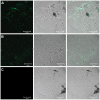Microspectroscopic evidence of cretaceous bone proteins
- PMID: 21559386
- PMCID: PMC3084868
- DOI: 10.1371/journal.pone.0019445
Microspectroscopic evidence of cretaceous bone proteins
Abstract
Low concentrations of the structural protein collagen have recently been reported in dinosaur fossils based primarily on mass spectrometric analyses of whole bone extracts. However, direct spectroscopic characterization of isolated fibrous bone tissues, a crucial test of hypotheses of biomolecular preservation over deep time, has not been performed. Here, we demonstrate that endogenous proteinaceous molecules are retained in a humerus from a Late Cretaceous mosasaur (an extinct giant marine lizard). In situ immunofluorescence of demineralized bone extracts shows reactivity to antibodies raised against type I collagen, and amino acid analyses of soluble proteins extracted from the bone exhibit a composition indicative of structural proteins or their breakdown products. These data are corroborated by synchrotron radiation-based infrared microspectroscopic studies demonstrating that amino acid containing matter is located in bone matrix fibrils that express imprints of the characteristic 67 nm D-periodicity typical of collagen. Moreover, the fibrils differ significantly in spectral signature from those of potential modern bacterial contaminants, such as biofilms and collagen-like proteins. Thus, the preservation of primary soft tissues and biomolecules is not limited to large-sized bones buried in fluvial sandstone environments, but also occurs in relatively small-sized skeletal elements deposited in marine sediments.
Conflict of interest statement
Figures








References
-
- Zhang F, Kearns SL, Orr PJ, Benton MJ, Zhou Z, et al. Fossilized melanosomes and the colour of Cretaceous dinosaurs and birds. Nature. 2010;463:1075–1078. - PubMed
-
- Lindgren J, Caldwell MW, Konishi T, Chiappe LM. Convergent evolution in aquatic tetrapods: insights from an exceptional fossil mosasaur. PLoS ONE. 2010;5(8):e11998. doi: 10.1371/journal.pone.0011998. - DOI - PMC - PubMed
-
- Kaye TG, Gaugler G, Sawłowicz Z. Dinosaurian soft tissues interpreted as bacterial biofilms. PLoS ONE. 2008;3(7):e2808. doi: 10.1371/journal.pone.0002808. - DOI - PMC - PubMed
-
- Asara JM, Schweitzer MH, Freimark LM, Phillips M, Cantley LC. Protein sequences from mastodon and Tyrannosaurus rex revealed by mass spectrometry. Science. 2007;316:280–285. - PubMed
Publication types
MeSH terms
Substances
LinkOut - more resources
Full Text Sources

